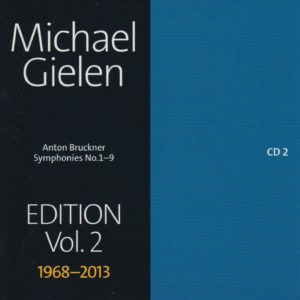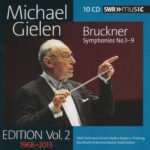 This morning’s conductor of Anton Bruckner’s Symphony No. 2 in C Minor (WAB 102) is Michael Gielen (1927-), an Austrian conductor and composer with a very long and lauded career who just recently (2014) retired from conducting for health reasons.
This morning’s conductor of Anton Bruckner’s Symphony No. 2 in C Minor (WAB 102) is Michael Gielen (1927-), an Austrian conductor and composer with a very long and lauded career who just recently (2014) retired from conducting for health reasons.
I first encountered Mr. Gielen on Day 4 of my 144-day journey.
Of Bruckner’s Second Symphony, its entry (“Anton Bruckner – An Introduction by John F. Berky”. Abruckner.com.) on Wikipedia has this to tell us about it:
Anton Bruckner’s Symphony No. 2 in C minor was completed in 1872, and revised, like most of Bruckner’s other symphonies, at various points thereafter. This work is sometimes known as the “Symphony of Pauses”.
It was composed after the Symphony “No. 0” in D minor (which was itself composed after the Symphony No. 1 in C minor). It is the only “official” Bruckner symphony (that is to say, excluding “No. 0”) without a dedication: Franz Liszt tacitly rejected the dedication, and Richard Wagner chose the Symphony No. 3 in D minor instead. The premiere was given with Bruckner himself conducting in 1873.
Fascinating.
Equally fascinating is this, found on the Wikipedia entry for Anton Bruckner:
“Bruckner expanded the concept of the symphonic form in ways that have never been witnessed before or since. When listening to a Bruckner symphony, one encounters some of the most complex symphonic writing ever created. As scholars study Bruckner’s scores they continue to revel in the complexity of Bruckner’s creative logic.”
 Listening to Michael Gielen’s interpretation of Bruckner’s Symphony No. 2 in C Minor, I can attest to that glowing overview of his music.
Listening to Michael Gielen’s interpretation of Bruckner’s Symphony No. 2 in C Minor, I can attest to that glowing overview of his music.
First up, the objective aspects of this recording:
Bruckner’s Second Symphony, composed in 1872
Michael Gaielen conducts
Rundfunk-Sinfonieorchester Saarbrucken plays
The version used is 1877, the Haas Edition
The symphony clocks in at 60:39
This was recorded in 1968 in Saarbrucken
Gielen was 41 when he conducted it
Bruckner was 48 when he composed it
It was released on the SWR Music Record Label
Bruckner wrote his symphonies in four parts. The time breakdown of this one (Symphony No. 2 in C Minor, 1877 Haas Edition), from this particular conductor (Gielen) and this particular orchestra (Rundfunk-Sinfonieorchester Saarbrucken) is as follows:
Allegro……………17:59
Adagio……………16:02
Scherzo………….10:40
Finale………………15:57
Okay. Now for the subjective aspects to this morning’s listening:
My Rating:
Recording quality: 4 (slight tape hiss in the openings and quiet moments)
Overall musicianship: 5
CD liner notes: 4
How does this make me feel: 5
This almost made me do cartwheels this morning.
So far, this Gielen interpretation of one of Bruckner’s symphonies is my favorite! Out of all symphonies and all conductors and orchestras!
Here’s what I wrote about my experience this morning:
One of the reasons why I love music – especially Classical music – is because it truly is a universal language.
Take this morning, for example.
I arrived at Panera Bread at 6:05 in the a.m. and settled into my usual spot in the balcony by the fireplace. I’ve been here for 45 minutes, sipping their signature Light Roast, listening to a recording of Anton Bruckner’s Symphony No 2 in C Minor.
Bruckner, an Austrian, composed his Second Symphony in 1872. This performance was conducted by Michael Gielen, another Austrian. Music was supplied by the Rundfunk-Sinfonieorchester Saarbrucken, a German orchestra. This was recorded in March of 1968 – nearly 50 years ago. And here I am, an American in Grandville, Michigan, listening to what Bruckner composed.
I can’t imagine what was going on in Bruckner’s life at the time he wrote this piece of music. I do know he was 48, single, and living in Vienna. Obviously, he had no way of knowing that 144 years later I’d be listening to his musical thoughts. Yet, it feels like he wrote this music just for me.
For example, around the 7:38 mark of Movement II (Adagio), there’s a very pleasant passage that features pizzicato. I love pizzicato (that’s the Italian word to describe the plucking of stringed instruments). It reminds me of cartoon characters trying to sneak up on each other. A solo French horn enters at the 7:42 mark and provides a beautiful counterpoint melody that creates an exceptionally joyful listening experience, especially throughout the rest of the movement as strains of the French horn’s melody are replayed. (I love French horn, especially as played by the late English horn player Dennis Brain – talk about magical!)
Classical music, no matter how long ago it was composed, regardless of the language of the composer, can be played by any orchestra in the world today. To me, that’s akin to planting and watering 2,000-year-old seeds discovered in an archeological dig in Egypt…and having them grow. To think that musicians can recreate what the composer put down on paper hundreds of years ago…
It brings history to life with each performance.
Yeah. Give me a piece of Classical music and a good cup of coffee (even this Light Roast will do) and I’m in heaven.
My wife, on the other hand, isn’t so enamored. It’s 6:30 in the morning. She’s doing her best not to fall asleep in the chair beside me.
Sleep is a universal language, too, I guess.
My wife speaks fluent sleep.
___
Everything about this recording is amazing. The volume is high, without being distorted. There’s a bit of tape hiss. But not too noticeable.
The first time I heard Gielen it was on (Day 4, and the symphony was Bruckner’s First.
Here’s what I wrote about that first encounter:
This is an odd one for me.
The recording was superb.
The performance was also superb.
Yet, this didn’t move me. It seemed so, for want of a better word, big.
Bold. Grand. Robust. Full. Rich.
Yet, all those qualities, this morning, fit perfectly in every way. Bruckner’s Symphony No. 2 seems to need what Gielen and Rundfunk-Sinfonieorchester Saarbrucken brought to the table in March of 1968.
This is, truly, inspired music.
Highly recommended.
